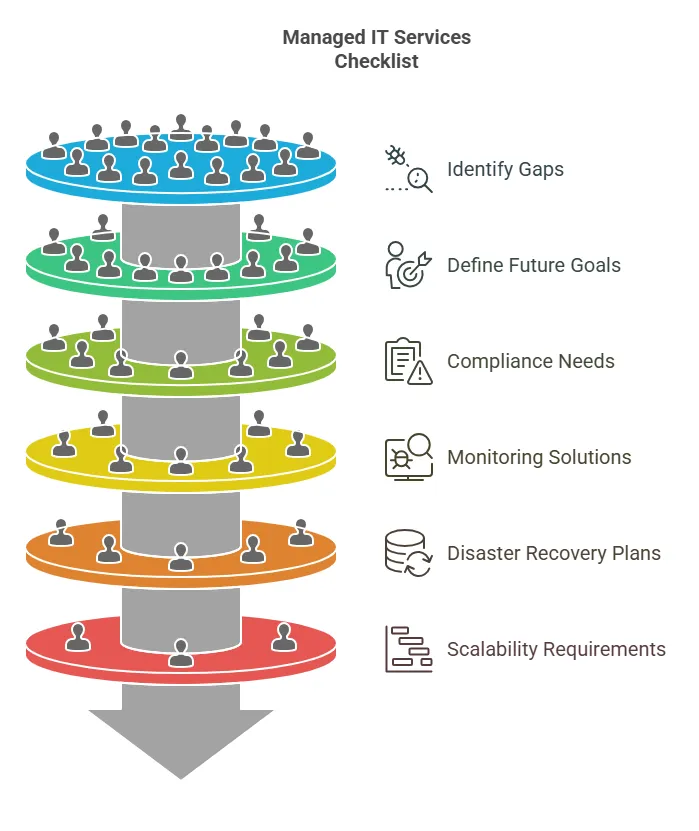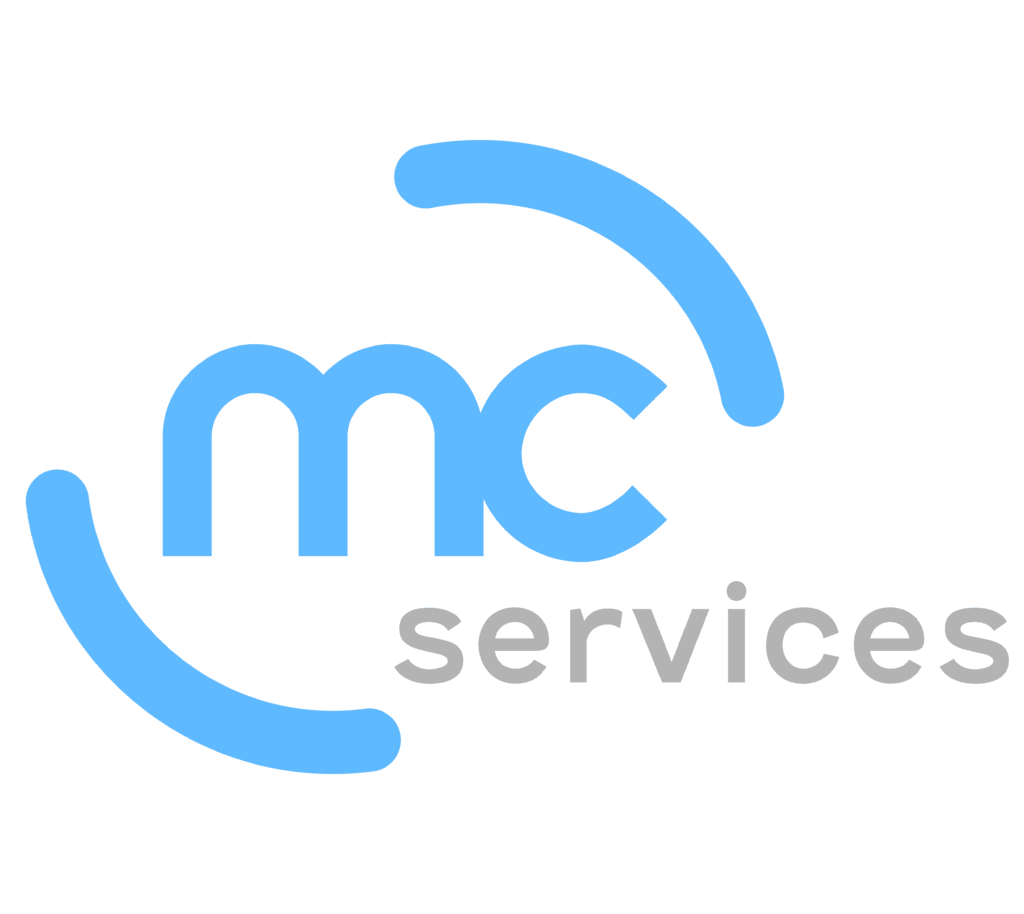According to CloudSecureTech, Downtime costs for small businesses range from $137 to $427 per minute. You’ve got ambitions to scale, but every data breach threat and unexpected outage could knock you off course.
Duane Maas, Director at MC Services notes that “A technology partner that anticipates challenges is worth far more than one who only reacts to them.”
When vendor after vendor promises “the best deal,” finding the right partner can feel like a gamble. Now is the time to put confusion aside. Let’s dive into the must-have insights that will help you make an informed choice and keep your operations running at peak performance.
Boost Your IT Efficiency and Security with Managed Services!Gain expert IT support and reduce downtime without the overhead of an in-house team. |
Why the Right IT Partner Matters
When your IT infrastructure falters, everything from employee productivity to customer trust takes a hit. According to the Cybercrime Magazine, 60% of small companies go out of business within six months of falling victim to a cyberattack. You need a partner who doesn’t merely fix problems; rather, one who actively prevents them. Weak spots in your network, outdated software, and poor support can cost you both time and customers. That’s why choosing the right IT provider is not just nice to have—it’s essential for business survival.
Assemble Your Managed IT Services Checklist
A well-structured checklist is your roadmap to pinpointing exactly what services you need—and what a potential IT partner must deliver. Start by looking inward: evaluate your current infrastructure and identify performance gaps or vulnerabilities. Then, formulate a clear vision of where you want to be in one, three, and five years. Understanding your trajectory helps you gauge the depth of services required, from security protocols to specialized software management.
- Compliance and Regulation
If your business operates within a regulated industry—like healthcare or finance—you’ll need specific compliance measures in place. Confirm your potential partner’s experience with frameworks such as HIPAA or PCI DSS and ask how frequently they conduct audits or policy updates to maintain compliance. - Infrastructure Monitoring and Maintenance
Round-the-clock monitoring can mean the difference between spotting an issue early and dealing with a major system meltdown. Ask about automated alerts, dedicated monitoring teams, or advanced analytics tools. The more proactive the monitoring, the less downtime you’re likely to face. - Disaster Recovery and Business Continuity
Natural disasters, cyberattacks, or even human error can trigger catastrophic data loss. Look for robust disaster recovery (DR) plans, including near real-time backups and tested restoration procedures. It’s crucial that your provider can quickly restore operations so you don’t lose valuable time or revenue. - Scalability and Long-Term Strategy
Growing businesses often adopt more complex IT architectures over time. Whether you plan to expand to multiple locations or integrate new digital platforms, confirm the provider’s ability to scale. This might include flexible service tiers or a technology roadmap that anticipates emerging trends.
Your managed IT services checklist should ultimately reflect your unique challenges and goals. By clarifying exactly what you need—and ensuring your potential partner can deliver on every point—you set the stage for a partnership that supports your business now and well into the future.

| More articles you might like: |
Create a Managed IT Services Questionnaire
A comprehensive list of questions ensures you’re comparing candidates on an apples-to-apples basis. The goal? To uncover a provider’s true capabilities, approach to problem-solving, and the depth of their commitment to clients.
- Operational Structure & Coverage
Ask about support hours, on-site versus remote assistance, and any guaranteed response times. For instance, do they offer 24/7 support? Will you have a dedicated account manager who understands your business? Answers to these questions highlight their level of personalized service. - Technical Expertise & Credentials
Certify their certifications. Inquire about vendor partnerships (e.g., Microsoft, Cisco), relevant technical training, and experience in your sector. If your industry uses specialized software, find out if they’ve integrated and managed it before. - Reporting & Transparency
Ask how they measure and report on system performance, security incidents, and resolution times. A provider that offers monthly or quarterly performance reviews—complete with actionable insights—demonstrates accountability and a willingness to optimize. - Future Alignment
Your IT strategy should align with your broader business objectives. Ask how the provider plans to accommodate shifting requirements—like adding cloud capabilities, scaling storage, or upgrading hardware. This helps you see if they think beyond break-fix approaches.
This managed IT services questionnaire sets the tone for in-depth conversations that reveal each provider’s strengths and weaknesses. You’ll also gain a clearer sense of who’s prepared to grow alongside you, rather than just patch immediate problems.
Essential Managed Services Qualifying Questions
Not all questions are created equal. Some target surface-level issues, while others dig deeper into a provider’s methodology, experience, and strategic vision. Here are some that really count:
- “How do you handle security for remote or hybrid workforces?”
This question uncovers how adaptable the provider is in a post-pandemic work landscape. If they lack robust solutions for remote endpoints, you might face major security gaps. - “Which tools and processes do you employ for continuous threat detection?”
Their response reveals whether they rely on outdated antivirus software or cutting-edge solutions like Security Information and Event Management (SIEM) systems and advanced endpoint protection. - “What Key Performance Indicators (KPIs) do you track to show ROI?”
Managed services should go beyond ‘keeping the lights on’ by providing tangible returns—whether in cost savings, reduced downtime, or streamlined workflows. - “Can you provide references or case studies relevant to our industry?”
Real-world success stories are gold. They illustrate the provider’s adaptability and familiarity with challenges in your field. If they struggle to produce references, consider that a red flag. - “How do you maintain transparency and communication with clients?”
Ongoing, clear communication prevents surprises. Weekly check-ins, ticketing dashboards, or monthly strategy sessions can all ensure a healthy, proactive relationship.
These managed services qualifying questions dig beyond marketing fluff to expose how deeply a provider understands and can deliver on your unique needs. The more precisely you question them, the clearer your path to a solid decision.
How to Choose a Managed IT Provider and Seal the Deal
With proposals in hand, you might still wonder how to confidently pick one partner over another. It’s a common dilemma—especially when multiple providers check all the basic boxes. Here’s how to move from “I’m not sure” to “Let’s do this.”
- Perform a Thorough Side-by-Side Comparison
Align each proposal’s scope, pricing, SLAs, and add-ons. Break it down to see which provider offers both the most immediate and long-term value. The cheapest option might save money now but risk higher costs down the road if they’re unable to scale or prevent cyberattacks effectively. - Evaluate Culture and Communication Style
Even the best technology partner can fail if their communication style doesn’t mesh with yours. Do they patiently answer questions? Are they transparent about limitations or challenges? Look for a provider whose company culture aligns with how you do business. - Negotiate the SLA for Clarity and Protection
No matter how great the pitch, the Service Level Agreement is where promises become binding. Lay out expected response times, escalation paths, security responsibilities, and penalties for failing to meet these benchmarks. Don’t hesitate to request modifications—this is your safety net. - Test a Small Project Before Committing Fully
If you’re on the fence, propose a pilot project to evaluate their performance and collaboration style in real-world conditions. This helps confirm if they truly understand your environment and can deliver as advertised. - Trust Your Intuition
Ultimately, technology is run by people. If you sense genuine concern for your success, open communication, and strong expertise, you’ve found a promising match. Sealing the deal should feel like stepping forward with a partner you can grow alongside.
Red Flags to Watch Out For
You might come across IT providers who sound great on paper but reveal hidden pitfalls once you dig deeper. Keep your radar up for the following:
- Vague or Generic SLAs
SLAs that don’t mention specific response times, uptime guarantees, or accountability measures can lead to endless finger-pointing and untracked delays. - Limited Scalability Path
A one-size-fits-all service often means you’ll outgrow the partnership. Without clear plans for expansion—like additional data centers or advanced cybersecurity—your business could plateau technologically. - Opaque Pricing Structures
Watch out for hidden fees or “optional extras” that magically appear after signing. An honest provider should be upfront about all costs for a clear comparison. - Shallow Technical Expertise
If the conversation never goes beyond basic support or help desk services, they may not be prepared to handle more complex tasks—like multi-cloud integrations or stringent compliance requirements. - Poor Communication or Lack of References
Providers who dodge direct questions or fail to connect you with current clients may be hiding something. Credible partners want to highlight their successes and demonstrate their reliability.
Identifying red flags early can save you from friction-filled relationships that cost both time and money. Remember: a managed IT provider should be a proactive ally, not just another vendor.
Comparison Table
| Feature/Consideration | Provider A | Provider B | Provider C |
| Pricing Model | Flat Monthly Fee + Add-ons | Tiered Package Plans | Per-User or Per-Device |
| Response Time Guarantee (SLA) | 30 Minutes | 1 Hour | 15 Minutes |
| Security Protocols | Basic Antivirus | Advanced Endpoint Protection | Full SOC & SIEM Services |
| Scalability & Growth Planning | Limited or None | Offers Basic Forecasting | Roadmap for Emerging Tech |
| Cloud Integration Support | AWS Only | AWS & Azure | AWS, Azure, & Google Cloud |
| On-Site Support | Extra Fee | Included in Higher Tier | Included in All Tiers |
Partnering with MC Services for a Secure, Scalable Future
Choosing the right IT partner is about more than patching software or fixing servers; it’s about setting the foundation for ongoing success. From building a managed IT services checklist to asking managed services questions to ask, you now have the tools to compare providers with confidence. By focusing on transparency, customization, and growth-oriented solutions, you’ll sidestep costly downtime and gain a real competitive edge. MC Services stands ready to guide you every step of the way. For cutting-edge expertise and a commitment to your business’s long-term prosperity, contact MC Services today to schedule a personalized consultation.
| Trusted Managed IT Services Near You
|
||||||


